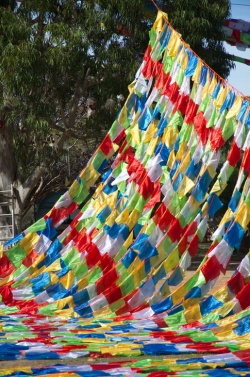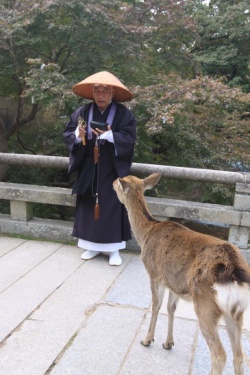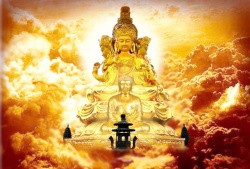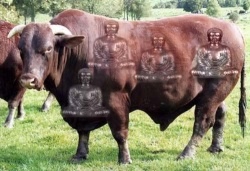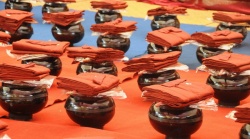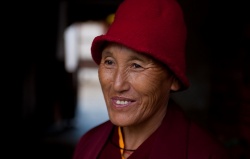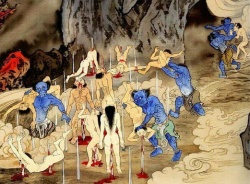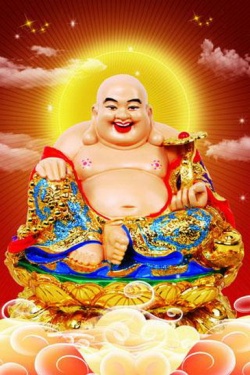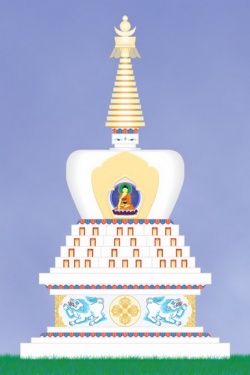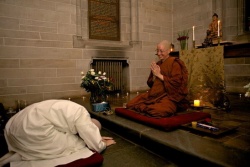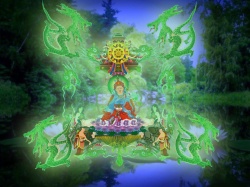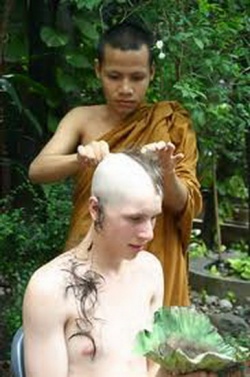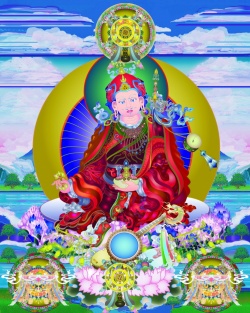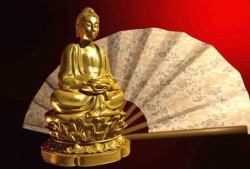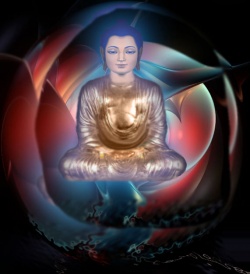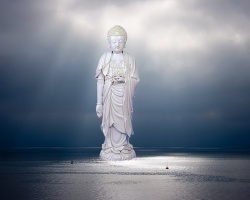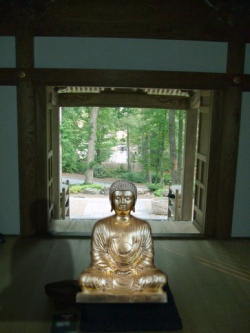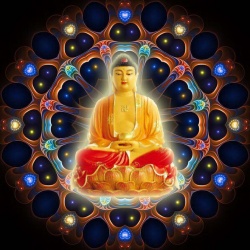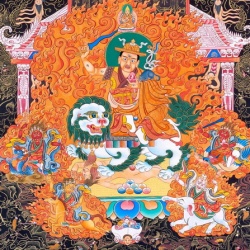The Grand Prayer that Blesses and Benefits All Sentient Beings
Significance of The Grand Prayer that Blesses and Benefits All Sentient Beings
The Grand Prayer that Blesses and Benefits All Sentient Beings or commonly known as Water-land Dharma Assembly (水陆法会) is one of the grandest and most powerful of Chinese Buddhist pujas. Its full name is “The Supreme Assembly of Enlightened and Ordinary Beings within the Dharma Realm To Offer Great Generosity and Universally Liberate Beings of Water and Land”.
1. “Dharma Realm” refers to the equality of the essential nature of the Buddhas and ordinary beings, and the oneness of the ordinary and extraordinary views.
2. “Enlightened and Ordinary Beings” refers to the 10 Dharma Realms of which there are Four Enlightened Realms, i.e. the realms of the Buddhas, Bodhisattvas, Solitary Realisers and Arhats; and the Six Unenlightened Realms, i.e. the realms of Gods, Humans, Asuras, Hell Beings, Hungry Ghosts and Animals.
3. “Water and Land” refers to the places where the beings of water, land and air reside and experience their ripened karma. As creatures that fly still needs to rest on the earth, they are therefore included together with the beings of the earth, and referred to as “Water and Land”. However, since beings who live in water and on land experience more intense suffering, while those in the air, such as beings residing in the Heaven of Desire or Heaven of Form experience more bliss and happiness, the Puja places more emphasis on benefiting beings living in the water and on land. Hence, its name “the Water and Land Puja”.
4. “Universally Liberate” refers to the act of universally delivering all sentient beings from suffering. “Great” in the Buddhist tradition has three meaning: Large, Numerous & Supreme. In this context, it is to describe how this Dharma assembly is large in scale, it is numerous in the number of sutras and practices carried out and supreme in its goal, Nirvana!
5. “斋 Purity Uposatha” refers to the observance of precepts, in particular partaking of food at the proper time (for cultivation). Today, in Mahayana tradition, it includes abstention from meat. In this context, it refers to the (dana) offering of vegetarian food to the Mahasangha (Buddha, Paccekabuddha, Bodhisattvas, Arahants & the monastic sangha), while they gather and practise during this Dharma assembly and also to sentient beings from all realms.
6. “Supreme Assembly” refers to the assembly for the purpose of sharing the Dharma. In addition to offering food and water to sentient beings, giving of the Dharma is also performed through reciting sutras and mantras, enabling sentient beings to receive the nourishment of the Dharma so that they can be freed of their mental suffering and achieve happiness. “Assembly” also holds the meaning of a gathering. This is an occasion where teachers and those who are to be guided are gathered in one place; where food, drinks and the Dharma are gathered in one place, as such, it is known as an Assembly.
In short, the purpose of the Water – Land Dharma Assembly is to liberate sentient beings from suffering by generating extensive merit through the offering of Food and Dharma so that they can attain happiness and enter into the path of Buddhahood.
In essence, the Puja can be summarised by the dedication verses chanted after reciting the Mantra for Transforming Food during offering ceremonies at Buddhist temples.
“This food with its form, smell and taste, I offer above to the Buddhas of the Ten Directions. In the middle, I offer to the various Holy Beings and Sages. Below, I offer to the beings of the Six Realms. These are offered equally without any discrimination. All shall be satiated and fulfilled according to their individual desires.”
“The Three Qualities and Six Tastes, I offer to the Buddha and Sangha, and all sentient beings of the Dharma Realm. I make this offering equally to all. ”
In the middle, the dedication verses to the Sponsors read: “May those who offered today, attain infinite Perfections.”
The Water and Land Puja is divided into the Inner Shrine Puja and Outer Shrine Puja. In terms of the content of the puja, the emphasis is on the Inner Shrine. Starting from 2.00 am on the third day of the Puja, the Inner Shrine serves mainly as the centre of communications with the Four Enlightened Realms and the Six Ordinary Realms – it is the heart of the Water and Land Puja, so to speak.
As the Inner Shrine Pujas are complex and require great concentration for visualisation on the part of the Master conducting the ceremony, after the shrine boundaries are established, chief sponsors and above would enter the shrine set to represent all sponsors to participate in the Pujas. This is to prevent disruption to the puja in the Inner Shrine.
The Water and Land Puja requires seven days and nights to complete. During the seven days and nights, sutras will be recited.
Origins of the Water and Land Puja
The festival is attributed to Emperor Liang Wu Di of the Liang Dynasty. The Emperor had a dream in which a holy monk advised, “The beings of the four kinds of birth and six paths of existence undergo countless sufferings. Why don’t you establish a great vegetarian offering for sentient beings everywhere, those who live in water and on land, and save them?” Under the encouragement of Venerable Master Jue Gung, Emperor Liang Wu Di researched the Buddhist cannon and created a text combining the practices of Liang Huang Repentance Ceremony, the Sutra Describing Venerable Ananda’s Encounter with Ghost King Blazing Face, and a ceremony for making universal offering of food to the ghosts and spirits of the departed from the three realms of existence. Subsequently, “Extensive Unlimited Offerings to the beings of the Spirit Realms”, a text from the Tang Dynasty Vajrayana Tradition, was added to the Puja to from the complete version that we have today.
What makes the Water and Land Puja so unique?
A single Water and Land Puja takes seven days and nights to complete. The venue for the ritual itself is divided into the Inner Shrine and the Outer Shrines. The Outer Shrines can be further subdivided into the Grand Shrine, Shrine of the Various Sutras, Lotus Shrine, Pureland Shrine, Surangama Shrine and Flower Adornment Shrine. Every shrine is equally important. Together, they constitute the Water and Land Puja.
Each Water and Land Puja requires the involvement of tens to approximately a hundred monastics. As the manpower and resources required are considerably huge, most temples would not hold a Water and Land Puja without giving it due consideration.
What are the various names of the Water and Land Puja?
(1) It’s known as the “The Water and Land Assembly” for short (2) The Water and Land Way-place (3) The Festival of Compassionate Benefit (4) The Great Festival of Unlimited Offerings to Beings of Water and Land (5) The Great Festival to Benefit both the Living and Deceased in Heaven and Earth, Water and Land (6) The Supreme Assembly of Enlightened and Ordinary Beings within the Dharma Realm To Offer Great Generosity and Universally Liberate Beings of Water and Land.
What are the benefits of participating in the Water and Land Puja for the living and the deceased?
1. Benefits for the living:
Since one is making offering of food above to the Buddhas, Bodhisattvas and all holy beings, and below to all sentient beings of the Dharma realm, the amount of merit arising from this is definitely inconceivable and boundless. Those who practise giving (making offerings) are sure to reap its rewards. Those who take delight in giving, will surely find peace and happiness. The Sutra on Offering Food says: “one shall be blessed with long life; a strong, healthy and good-looking body; wealth and reputation; and skill in debate”. An ancient master says: “Those who make offerings to only one Buddha or to only one monk accumulate an infinite amount of merit. In this case, one is making offerings to the Triple Gem of the ten directions and the tens of thousands of sentient beings within the Six Realms. The merit arising from this is definitely going to benefit not only oneself, but also one’s immediate and extended family.”
2. Benefits to the deceased:
1. For those who have not generated Bodhicitta (the altruistic intention to achieve Buddhahood in order to benefit sentient beings), strong Bodhicitta shall arise due to this supreme Water and Land Puja.
2. For those who are not liberated from the suffering wheel of Samsara, they shall attain the state of non-regression.
3. For those who have not attained Buddhahood, they shall achieve perfect Buddhahood because of this supreme event.
What sutras and mantras are recited during the Water and Land Puja?
1. Flower Adornment Sutra – one set
2. Surangama Sutra – 24 sets
3. Lotus Sutra – 24 sets
4. Sutra of Golden Light – 24 sets
5. Sutra of Perfect Enlightenment –24 sets
6. Sutra of Infinite Life – 24 sets
7. Sutra of Contemplation On Amitabha Buddha – 24 sets
8. Diamond Sutra – 120 sets
9. Medicine Buddha Sutra – 120 sets
10. Brahma Net Bodhisattva Vows – 48 sets
11. Sutra of the Past Vows of the Earth Store Bodhisattva – two sets
In addition the following Pujas are also performed:
- 24 sets of the Emperor Liang Repentance Ceremony;
- Two sets of the Great Compassionate Repentance Ceremony;
- Recitation of the Amitabha Sutra and Mantras for seven continual days; and
- Five sessions of Puja Food Offerings to Hungry Ghosts.
How many members of the Sangha are required to conduct the Water and Land Puja?
1. Inner Shrine: Six persons, including the Chief Dharma Master, Representative, Deputy Representative, Light and Incense Manager, Attendant.
2. Outer Shrines: Grand Shrine (24 persons), Pureland Shrine (eight persons), Lotus Shrine (eight persons), Flower Adornment Shrine (two persons), Surangama Shrine (eight persons), Shrine of Various Sutras (eight persons), Shrine Supervisor (one person). Total of 59 persons. If the venue is large, the number of Sangha members involved can be more than this.
3. In addition, members of the Sangha are also required to take on the roles of Monastic Reception Manager, Light and Incense Manager, Discipline Master and Attendants. It takes more than a hundred Sangha members to successfully organize a Water and Land Puja.
How many shrines are set up during the Water and Land Puja?
Inner Shrine:
Recites and makes prostrations to the Water and Land Puja Text, which contains the essential essence of the Buddhist Canon, making it the most powerful amongst all purification and deliverance ceremonies, capable of benefiting both the living and those in the spirit realms, creating an inconceivable amount of merit for liberation.
Emperor Liang Grand Shrine:
Performs 24 sets of the Emperor Liang Repentance Ceremony over a period of seven continuous days. Also performs the Puja Food Offerings to Hungry Ghosts, Vegetarian Food Offerings to the Celestial Beings, Grand Offerings to the Buddhas, and Animal Liberation to create an abundance of extensive merit to help liberate beings bound to the spirit realms.
Flower Adornment Shrine:
Recites one set of the Flower Adornment Sutra, which explains the greatness of the Buddha World and the ways and means to achieve perfect Buddhahood.
Surangama Shrine:
Recites 24 sets of the Surangama Sutra, which explains the method to accomplish the Surangama Samadhi, the foremost method for one to attain liberation and achieve perfect Buddhahood and to protect one from the harm of negative energies and entities.
Lotus Shrine:
Recites 24 sets of the Lotus Sutra, which explains the great compassionate activities of the Buddhas, invoking its powerful blessing.
Shrine of the Various Sutras:
Recites 24 sets each of the Sutra of Infinite Life, Sutra of Contemplating the Amitabha Buddha of Infinite Life, Sutra of Golden Light and the Sutra of Perfect Enlightenment. These sutras describe the various methods for attaining Liberation and also help one to purify all karmic obstacles and negativities such as untimely deaths and problems. Also recites 120 sets of the Medicine Buddha Sutra and the Diamond Sutra and 24 sets of the Sutra of the Brahma Net Bodhisattva Vows to purify negativities and avert disasters; and to pray for good health and the elimination of sickness so that one may enjoy a long, safe and healthy life.
Pureland Shrine:
Strong prayers are made for oneself and loved ones to be reborn in Amitabha Buddha’s Pureland of Ultimate Bliss at the time of death and also for those who have passed away to be reborn in Amitabha Buddha’s Pureland.
Who initiates the Water and Land Puja?
1. If a wealthy individual decides to solely undertake the sponsorship of the Puja, it is known as a Single Surname Water and Land Puja.
2. If a group of devotees come together to pool resources and raise funds to sponsor the Puja, it is known as a Water and Land Puja with Multi Surnames.
What is the difference between the Inner and Outer Shrines? Does the Inner Shrine create more merit? Or do the Outer Shrines create more merit?
1. Even though the Water and Land Puja is divided into seven shrines, all the shrines in fact combine to form one complete Puja. Each and every shrine is of equal importance, none can be omitted. If any one shrine is missing, the Puja would not be considered a Water and Land Puja.
2. Every day during the Puja, representatives from the Outer Shrines report to the Main Shrine thrice a day to read out a prayer of proclamation to the 10 Realms to dedicate the merits arising from the day’s sutra recitation. Therefore, for the Water and Land Puja, there is no difference between the Inner and Outer Shrines. By sponsoring according to their wishes, sponsors help accomplished the Water and Land Puja; and this is the greatest merit.
3. The merit of reciting sutras depends on one’s motivation and devotion. The purer the motivation and deeper the devotion, then the merit is great and extensive, and is immeasurable.
4. The Water and Land Puja is meant for devotees everywhere to attend and create merit, and to enjoy its wonderful benefits so that everyone equally receives its incredible blessings.
5. In terms of the content of the Pujas, the emphasis is on the Inner Shrine.
6. The Inner Shrine mainly serves as the centre of communications with the Four Enlightened Realms and the Six Ordinary Realms – it is the heart of the Water and Land Puja.
7. Due to the complex nature of the Inner Shrine Pujas and the heavy karmic responsibility of the Master conducting the ceremony, it is important for the Master to maintain full concentration on the Pujas. Therefore, boundaries are set for the Inner Shrine.
8. To prevent any unwanted intruders, only selected sponsors are allowed into the shrine to represent all the sponsors participating in the Pujas.
A banner is always put up during the Water and Land Puja. What are the words written on the banner? Where is it put up? Why do you put up the banner during the day and replace it with the Nine Lanterns at night?
1. Written on the banner is: “Precious Banner for The Supreme Assembly of Enlightened and Ordinary Beings within the Dharma Realm To Offer Great Generosity and Universally Liberate Beings of Water and Land”.
2. It is put up on a pole on the left at the front of the Hall of Great Strength, or at a higher place.
3. The banner is raised during the day so that beings from many miles away can clearly see it.
4. At night, the banner is replaced by lanterns so that wandering spirits from afar can come to attend the Puja and receive the blessings of the Dharma.
Where was the first Water and Land Puja held?
According to A Chronicle of the Buddhas and the Patriachs, it was held during the 4th year of Emperor Liang Wu Di’s Tian Jian era at the Golden Mountain Temple in Zhenjiang. The Puja Sponsor was Emperor Liang Wu Di. The chief Puja Master was the Venerable Zeng You.
What is the significance of the Puja to Purify The Grounds?
1. During the Puja, blessed water is sprinkled around the environs of the Temple. Through the power of the blessed water, everywhere that it touches, above – below, and the four directions – is transformed and becomes a protected place.
2. All flowers, food and other offerings become incredibly beautiful.
3. The sense faculties of the monks and lay people participating in the Puja become pure.
4. The body and mind of the sponsors become complete.
5. If anyone were to enter the Puja boundaries with unclean bodies or attire, or without first observing a vegetarian diet, whether he or she entered the Shrine intentionally or by accident, due to the power of the mantras and the blessed water, the person will be transformed and purified.
6. The areas above, below and in the four directions of the Puja venue becomes huge and beautiful like the realms of the Buddhas, such that the venue becomes a suitable place for a Dharma Assembly to be held.
What is the significance of Setting Boundaries?
Through reciting mantras and performing the boundary setting Puja, the areas below the ground, on the ground and in the air are transformed into a three-dimensional Mandala. It is clean and pure like Lapis Lazuli and fortified like the Vajra Stupa, making it unassailable by negative beings. The venue becomes a suitable place for inviting the Buddhas and Bodhisattvas to come and for sentient beings of the six realms to gather and receive the blessings of the Dharma.
What is the significance of Issuing the Divine Runes and Raising the Banner?
Issuing the Divine Runes is like issuing letters of invitation to the celestial court in heaven and to the hells so that heavenly gods, Buddhas and Bodhisattvas, and sentient beings of the six realms are all invited to come to the Dharma event. A banner bearing the words “Precious Banner for The Supreme Assembly of Enlightened and Ordinary Beings within the Dharma Realm To Offer Great Generosity and Universally Liberate Beings of Water and Land” is raised high in front of the venue where the Water and Land Puja is held. Beside the banner are hung nine Lotus Lanterns. The nine lanterns serve as a means of illumination at night, as well as a location marker.
What is the significance of Inviting the Upper Hall?
Inviting the Upper Hall means to respectfully invite the Buddhas, Bodhisattvas and Sages to come to the Puja, and to request them to teach the Dharma for the benefit of sentient beings.
What is the significance of Making Offerings to the Upper Hall?
This refers to the act of making offerings to the Buddhas, Bodhisattvas and Sages who have been invited to be seated at the 10 banquet tables inside the Inner Shrine. The offerings, which are pleasing to the six senses, are made by the Puja sponsors to express their devotion and respect to the holy beings.
What is the significance of Inviting the Lower Hall?
Inviting the Lower Hall means to invite the sentient beings of the six realms to come and participate in the Puja.
What is the significance of Making Offerings to the Lower Hall?
This refers to making offerings to the sentient beings who have been invited to be seated at 14 banquet tables. The offerings are pleasing to the six senses (form, sound, smell, taste, touch and phenomena.) The eye sees form – precious jewels; the ear hears sounds – music; the nose smells fragrances – sublime incense; the tongue savours tastes – food; the body feels – sublime robes, the mind perceives phenomena – Buddha Dharma. These offerings help humans to realise the truth and return to a life of purity, asuras to overcome their anger, hungry ghosts to become satiated and filled, animals to acquire wisdom, and hell beings to gain freedom from their painful existence.
Note: By relying on the six sense faculties and the six consciousnesses, sentient beings perceive the six sense objects. These impure objects are transformed into pure offerings, pleasing to the six sense faculties.
What are the Offerings Pleasing to the Six Sense Faculties?
The Six Sense Objects are: form, sound, smell, taste, touch, and phenomena.
Our Six Sense Faculties: eye, ear, nose, tongue, body and mind, rely on the Six types of Consciousness – eye consciousness, ear consciousness, nose consciousness, tongue consciousness, body consciousness, and mind consciousness to discriminate and perceive the six sense objects. The sense faculties, sense objects and sense consciousnesses are dependent on one another. A lone sense faculty or consciousness cannot arise on its own.
Through the miraculous blessing power of the Buddhas, these polluted sense objects are transformed into sublime offerings possessing the three virtues, namely: (1) Virtue of the Dharma Body, (2) Virtue of Wisdom and (3) Virtue of Liberation.
In terms of the objects that are used in the offerings, the sublime jewels represent Form, the chanting of prayers and sutras represents Sound, the burning of fragrant incense represents Smell, the offering of food and drinks represents Taste, visualising and offering divine robes represents Touch, explaining the Dharma to sentient beings of the six realms represents Phenomena.
As the mind arises, various phenomena arise. If participants visualise correctly according to the teachings, their prayers shall definitely be miraculously answered. In this Puja, they invoke the Buddha’s power to bless the six types of offerings and present the blessed offerings to the sentient beings seated at the 14 banquet tables.
What is the significance of the Notice of Amnesty?
During the Puja, a special envoy is sent out bearing two Letters of Amnesty and an Amnesty Document. These are presented to the great Indra and Brahma, and gods of the Earth to request their permission to allow the suffering sentient beings of the six realms to attend the Water and Land Puja.
What is the significance of Giving Precepts to the Deceased?
During this part of the Puja, the Three Refuges and the 10 Bodhisattva precepts are given to the deceased so that they may observe the precepts and refrain from all negativities of the Body, Speech and Mind, helping them to purify their mind and increase their virtue and positive tendencies.
What is the significance of the Completion Offerings?
After the granting of Precepts to the Deceased, everyone, including humans and gods, is jubilant and happy. The Completion Offerings are then offered universally to all the invited guests seated at the 24 banquet tables.
What is the significance of the Completion Incense?
The Completion Incense symbolises the dedication of the merits arising from the Water and Land Puja to all sentient beings with strong prayers for them to be reborn in the Pureland of Ultimate Bliss.
What is the significance of Sending Off the Judges and Reading the Proclamation?
This Puja invokes the Five Judges, requesting them to send the Five Judgment Proclamation to the various realms to proclaim the successful completion of the Water and Land Puja.
What is the significance of Sending Off the Holy Beings?
At this point of the Puja, the assembly of Enlightened and Holy beings are requested to return to their own abodes, and sentient beings of the six realms are guided to rebirth in the Pureland. All the prayer tablets are collected and put on the Ship to the Western Pureland. The ship is then offered to fire, signifying all departed beings have now been ferried across to the Pureland.
Who are Enlightened and Holy Beings that are invited when we perform the Puja to Invite the Upper Hall?
1. The Buddhas abiding in the ten directions and their entourage (Vairocana Buddha, Shakyamuni Buddha, Amitabha Buddha).
2. The Sublime Dharmas abiding in the ten directions and their entourage (Flower Adornment Sutra, Sutra of the Bodhisattva Vows, Sutra of Infinite Life, Sutra of Golden Light, Sutra of Contemplating the Buddha of Infinite Life etc. )
3. The Bodhisattva Sangha abiding in the ten directions and their entourage.
4. The Solitary Realiser Sangha abiding in the ten directions and their entourage.
5. The Hearer Sangha abiding in the ten directions and their entourage.
6. The lineage masters of the various Dharma lineages, such as the Zen and Vinaya traditions, and their entourage.
7. The heavenly beings possessing the five miraculous powers who assist in proclaiming the Buddha Dharma and in creating scriptural commentaries, and their entourage.
8. The Divine Dharma Protectors abiding in the ten directions, including the 10 Wisdom Kings, Vajra Krodha, the various Heavenly Kings and their entourage.
9. The godly Dharma Protectors abiding in the 10 directions who protect stupas and shrines housing Buddha relics, watch over monastic communities, and protect households and countries, and their entourage.
10. The 10 great sages who established and propagated the Water and Land Puja, and their entourage.
Who are the ordinary and heavenly beings that are invited when we perform the Puja to Invite The Lower Hall?
1. The Heavenly beings and their entourage abiding in the ten directions in the Form, Formless and Desire realms, including the sun, moon and stars.
2. Worldly gods and their entourage abiding in the ten directions in the air and in temples.
3. Kings, queens and concubines; military and court officials; Confucian sages and Taoist hermits abiding in the ten directions, and their entourage.
4. The 10 types of persons of various social status abiding in the ten directions, including farmers, workers, businessmen, physicians, fortune tellers, and their entourage.
5. The beings of the four types of birth and five realms of existence residing within the 10 directions, those who live in the mountains and beneath the seas, the asuras, and their entourage.
6. The Fire-Mouthed King of Ghosts and the various ghostly beings of the three classes and nine categories abiding in the 10 directions, including Hungry Ghosts, victims of untimely death, wandering spirits, and their entourage.
7. The Yama Kings, their sisters, the 18 lesser kings of hell, and the various hell officials abiding in the 10 directions, and their entourage.
8. All suffering beings abiding in the 10 directions who are bound to the eight hot hells, eight cold hells and the various hells, and their entourage.
9. The 10 categories of beings in the animal realm abiding in the 10 directions, including those with scales and those with feathers, and their entourage.
10. Beings from the various realms of existence abiding in the 10 directions who are currently in the intermediate state and taking rebirth once every seven days for a period of 49 days, and their entourage.
I think the puja in question is the "Grand Prayer that Blesses and Benefits all Sentient Beings", or "水陆法会“ in Chinese (literally means Puja of Land and Water). Its tradition dates back to Liang dynasty, when it was commissioned by Emperor Liang"
The puja is a very large scale one. The whole ceremony lasts 7 days and 7 nights of chanting of various important texts, and is divided into 7 altars or shrines. There is an inner shrine and 6 outer shrines, and they require 59 Bhikkus to lead the chanting in all 7 shrines. Other helpers are needed to help out with reception, cooking, admin, etc, and close to 100 people in total are required to organize such a large scale puja. Furthermore for the puja, for all 7 shrines, there needs to be many offerings such as oil lamps, flowers, fruits, vegetarian food, etc, and need to be replenished everyday for 7 days.
The cost of organizing such a grand puja is huge, considering the costs of tentage, the large amount of offerings required, and the amount of manpower involved. Typically (and historically), the cost of all 7 shrines are borne by a few sponsors from the laity for benefit of everyone who wishes to participate in the puja.
The reason why the inner shrine is restricted to few people is to minimize interruptions from having too many people moving in and out of the shrine, as the chief master presiding over it has to perform complex visualizations during the puja and requires full concentration. That is why only few people are allowed in the inner platform, and for expediency reasons only sponsors are allowed.
The outer shrines do not have such a restriction and people are free to attend them to dedicate merits to the deceased or to their families and friends. The outer shrines are free because of the donations of the sponsors. There is no difference in merits accrued from the outer or inner shrines.
Of course, one way to avoid misunderstanding is to disallow anyone into the inner shrine other than the presiding monks. But that also defeats the purpose, as most people (sad to say) would not want to sponsor the puja if there is no such privilege. So out of expedient means, and to be able organize the puja to benefit all sentient beings whether they have the means to sponsor or not, the tradition is to allow just the few sponsors into the inner shrine. This achieves two goals: to minimize the disruptions in the inner shrine as explained earlier, and to be able to conduct such a large scale puja to benefit all sentient beings.
